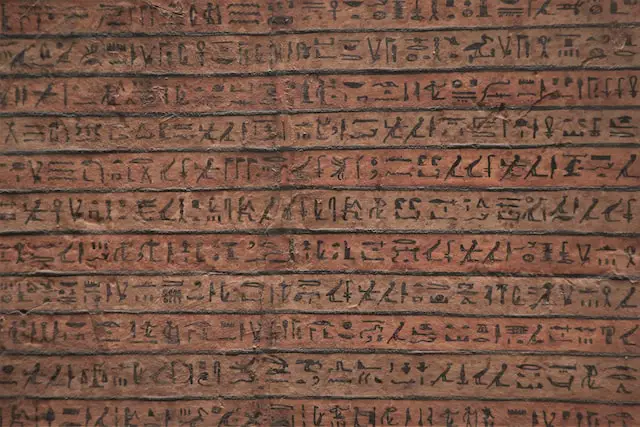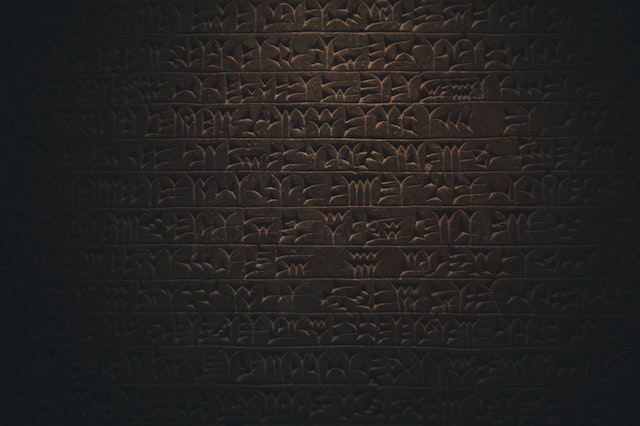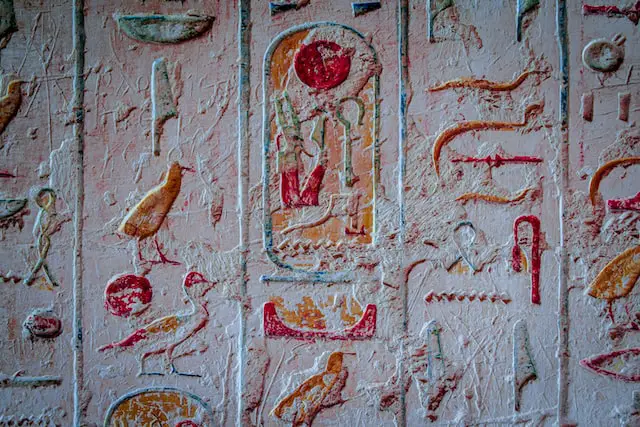For centuries, humans have used symbols to communicate. From ancient cave drawings to the hieroglyphics of Egypt and the cuneiform writing of Mesopotamia, these symbols represent an important part of our history. But what is the difference between hieroglyphics and cuneiform? This article explores the differences between hieroglyphics and cuneiform in order to provide a better understanding of how both forms of writing developed and evolved over time. We will also discuss how both forms are still being used today in various contexts, from archaeological discoveries to popular culture.
History of hieroglyphics
(Chris Linnett on Unsplash)

Hieroglyphics are one of the earliest forms of writing, dating back to around 3000 BCE in Ancient Egypt. The word hieroglyph comes from the Greek word for sacred carvings and was first used by Herodotus to describe the writing on the walls of temples and tombs.
Hieroglyphics were not just used for religious texts – they were also used for secular purposes such as storytelling, record keeping, and even personal letters. Each hieroglyph had a specific meaning and could be strung together to form words or sentences.
The use of hieroglyphics began to decline around the 4th century CE when Christianity began to spread throughout Egypt. Many of the old temples and hieroglyphs were destroyed during this time, and knowledge of how to read and write them was lost.
Fortunately, some examples of hieroglyphics have survived to the present day. One of the most famous is the Rosetta Stone, which was discovered in 1799 and helped scholars decipher the meaning of hieroglyphics. Today, hieroglyphics can still be seen in some ancient Egyptian temples, as well as in museums around the world.
History of cuneiform
(Egor Myznik on Unsplash)

Cuneiform was one of the earliest forms of writing, developed by the Sumerians in Mesopotamia around 3200 BC. It was used to write a variety of languages including Sumerian, Akkadian, and Eblaite.
The name cuneiform literally means “wedge-shaped”, referring to the wedge-shaped marks that were made on clay tablets with a reed stylus. The marks were generally arranged in horizontal rows and could be read from left to right or right to left.
Over time, cuneiform evolved into a more complex system of writing, with different signs representing different phonemes (sounds). This helped make it a more efficient form of communication.
It is believed that cuneiform influenced the development of other early writing systems such as hieroglyphics and Chinese characters.
Hieroglyphics Vs. Cuneiform – Key differences
The Egyptians invented hieroglyphics as a writing system, and it was used throughout the Mediterranean region during the Bronze Age. Hieroglyphics uses pictures and symbols to represent words and ideas, making it one of the first written languages.
Cuneiform, on the other hand, was developed by the Mesopotamians and is one of the oldest forms of writing. Cuneiform uses wedge-shaped symbols that were inscribed on clay tablets. It was used throughout Mesopotamia and parts of Asia Minor during the Bronze and Iron Ages.
How to read hieroglyphics and cuneiform
To read hieroglyphics, you need to understand the grammar and vocabulary of the Ancient Egyptian language.
What are 3 examples of hieroglyphics?
A hieroglyph can represent a word, sound, or a concept. There are over 700 hieroglyphs but many are quite rare.
| SYMBOL | NAME | WHAT IT REPRESENTS |
|---|---|---|
 | Ankh | This symbol represents life and was often seen in tomb paintings and inscriptions. |
 | Eye of Horus | A symbol of protection, royal power and good health. It is also known as the ‘Eye of Ra’. |
 | Scarab Beetle | A sacred beetle that was linked with the sun god, Khepri. It was seen as a symbol of rebirth and regeneration. |
What was the purpose of hieroglyphics?
The purpose of hieroglyphics was twofold: first, to serve as a record or log of the events that took place during the reign of the king; and second, to communicate messages to the gods. In essence, hieroglyphics were a way for the Egyptians to keep track of their history and their religion.
What was the purpose of cuneiform?
Cuneiform was a system of writing made up of wedge-shaped marks that was developed in Mesopotamia (an area that is now part of modern-day Iraq) around 4,000 years ago. It was the first form of writing in the world. It was used to write Akkadian, Assyrian, Babylonian, Elamite, Hittite, Hurrian, Sumerian, and Old Persian.
The purpose of cuneiform was to record and communicate information. For example, it was used to keep track of trade goods, to record astronomical observations, and to record laws and edicts. Cuneiform was also used for literary works, such as hymns, prayers, and myths.
Is cuneiform a hieroglyph?
Most people think of ancient Egyptian hieroglyphs when they think of pictographs – images that represent objects – but cuneiform was actually the first written language, originating in Mesopotamia (modern-day Iraq) around 3400 BCE. The name cuneiform comes from the Latin word for “wedge,” because the marks were made by pressing a reed stylus into soft clay. Cuneiform was used to write a variety of languages over its 3000-year history, including Akkadian, Sumerian, Elamite, and Hittite.
While cuneiform and hieroglyphs share the same origins – they both began as pictographs – they developed into very different writing systems. Hieroglyphs were used primarily by the ancient Egyptians to write their sacred texts, while cuneiform was used more for administrative purposes such as record keeping. And while hieroglyphs were usually written on papyrus or limestone, cuneiform was written on clay tablets which were then baked to preserve them.
So while cuneiform may be older than hieroglyphs, hieroglyphs are definitely the more well-known form of pictographic writing!
Featured Image By – Tom Podmore on Unsplash








